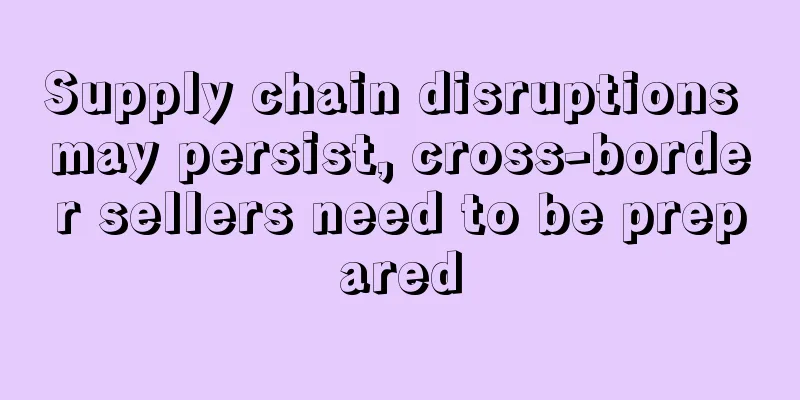Supply chain disruptions may persist, cross-border sellers need to be prepared

|
As we enter the second quarter of 2022, cross-border e-commerce sellers continue to be affected by supply chain disruptions caused by the epidemic, war, and inflation. According to Web Retailer's interviews with some top supply chain experts, this state of supply chain uncertainty will be a "new normal."
For retailers and cross-border sellers, the pressure of supply chain disruptions has led to a series of problems, such as reduced profits, increased transportation and warehousing costs, more buyers dissatisfied with delayed delivery times, and increased difficulties in shipping to overseas warehouses.
When it comes to the initial reason why cross-border e-commerce is in trouble in the supply chain, it is still the global outbreak of COVID-19. With the blockade of various countries, the outbreak of the epidemic has caused a domino effect:
COVID-19 lockdown > Increased e-commerce sales > Shortage of containers > Shipment delays > Congested ports > Shortage of dock workers > Shortage of truck drivers > Shortage of distribution warehouse space > Increased distribution and storage costs > Shortage of delivery drivers > Delayed deliveries > Unsatisfied customers > Reduced revenues for sellers and retailers > Increased prices by sellers, retailers and suppliers > Inflation.
At present, although the pace of the fall of dominoes related to the epidemic has slowed down, it is clear that some of them will not be reset to their normal positions, while others are in an "irregular" state of change.
However, just as the impact of the pandemic began to abate globally, the outbreak of the Russian-Ukrainian conflict set the second set of dominoes in motion. This time, rising fuel costs, economic sanctions against Russia, transportation resources for humanitarian or military needs, currency fluctuations and changes, etc., continue to weigh on the moving parts of the supply chain.
In addition, the impending port strike on the West Coast of the United States, potential U.S. legislation to harm e-commerce, and the uncertain outcome of the ongoing war have all had an impact on sales for cross-border sellers.
For cross-border sellers and retailers, what can they do to maintain their e-commerce business under such circumstances?
1. Place your order early. 2. To offset the adverse effects of longer delivery times, increase order volume. 3. Reduce reliance on just-in-time delivery. 4. Find alternative suppliers and sources of goods. 5. Consider hiring a supply chain expert to handle management of supply chain and logistics issues.
Judging from the current situation, it may take a year or more for the supply chain to stabilize, or it may never stabilize. But consumers' demand for online shopping and home delivery will continue to increase. The best thing sellers can do is to be prepared and flexible. Cross-border sellers Supply Chain The new normal |
>>: South Africa's e-commerce transactions to exceed $27.2 billion in 2025
Recommend
Shopee’s 12.12 Birthday Sale concluded with a 6-fold increase in platform traffic
On December 14, 2021, China's leading e-comme...
What is Shennuowei Logistics (Shanghai Shennuowei International Purchasing Co., Ltd.)? Shennuowei Logistics (Shanghai Shennuowei International Purchasing Co., Ltd.) Review, Features
<span data-docs-delta="[[20,{"gallery"...
What is Session Percentage? Session Percentage Review, Features
Session Percentage refers to the percentage of pa...
What is Huazong Logistics? Huazong Logistics Review, Features
Huazong Logistics (Shenzhen Huazong Logistics Co.,...
Online sales share in the UK rises, with strong growth in many categories
Recently, NielsenIQ released survey data showing ...
What is Zhiquancheng? Zhiquancheng Review, Features
Zhiquancheng is a one-stop cross-border logistics...
Wish suffered a net loss of $60 million in the first quarter, and the growth rate of platforms such as Amazon has also slowed down!
Since the end of April, major cross-border e-comm...
What is Shenzhen Shitong Technology Trading Co., Ltd.? Shenzhen Shitong Technology Trading Co., Ltd. Review, Features
Shenzhen Shitong Technology & Trading Co., Lt...
Logistics routes in many EU countries have reduced prices by up to 20%, and Cainiao has launched a Middle East transshipment center and other measures before 618
To help Chinese cross-border merchants better ser...
What is Beijing Zhixiang Information Technology Co., Ltd. (ZEASN)? Beijing Zhixiang Information Technology Co., Ltd. (ZEASN) Review, Features
Beijing Zhixiang Information Technology Co., Ltd....
An operations manager earns 22k, while a shipping agent earns 500k a month. Who is more attractive, a seller or a freight forwarder?
After the beginning of the year, the cross-border...
With sales exceeding 100 billion yuan in half a year, SHEIN wants to be even faster
Sales in half a year exceeded 100 billion yuan, a...
Attention! Multiple Amazon sellers received violation notices after listing products as collectibles
As early as a year ago, many Amazon sellers used ...
Awesome! Sellers make $5 billion in sales in a year with niche products
Seemingly insignificant categories often contain ...
What is Planet Communications? Planet Communications Review, Features
Planet Communications is a mobile Internet infras...









